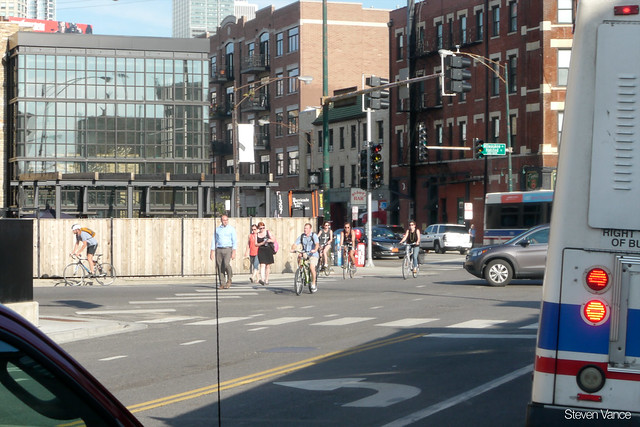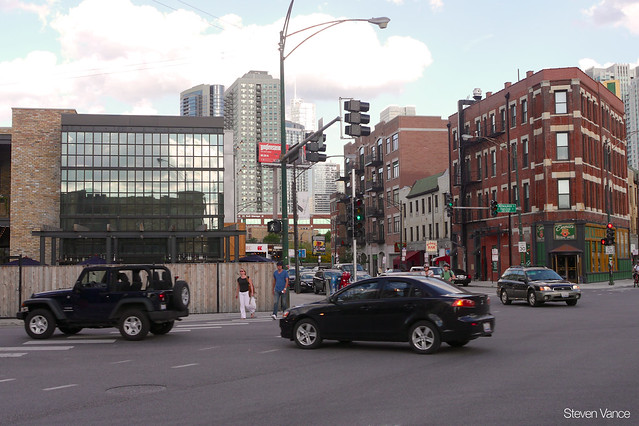
When left turn signals are installed, they typically turn green at the start of a street's green phase. However, simply reversing that order and putting left turns at the end of the green phase could reduce conflicts between turning cars and people walking in the same direction. As left turn signals have been installed at more Chicago intersections, motorists often are caught completing their left turns just as through traffic – and pedestrians – get a green light. The resulting conflict isn't safe for anyone.
It's standard engineering practice to have a "leading left turn phase," in which the green-arrow light for protected left turns goes first, before through traffic gets a green light. However, Chicago drivers often make left turns at the end of the green phase, after opposing traffic has cleared the intersection.
One example of an intersection where the leading left turn poses a problem for pedestrians is across Halsted Street at Grand and Milwaukee Avenues. During the weekday afternoon rush hour, and at peak times on weekends, motorists end up finishing their turns after through traffic has gotten a green -- and end up driving into a crowd of pedestrians. This has happened ever since October, when the Chicago Department of Transportation installed a left-turn signal on Grand Avenue.
To eliminate this conflict, the turn signal here could be shifted to a "lagging left turn," which puts left turns at the end of the phase, instead of at the beginning. Moving the left turn to the end of the Grand green light would allow pedestrians to cross once the light turns green, then allow any drivers waiting to make a left to finish their turns within a protected left-turn cycle.

Lagging left turns are highlighted by the Chicago Pedestrian Plan as a "tool for safer streets." The plan even mentions that, by reducing conflicts between pedestrians and vehicles, the lagging left turn can even improve car traffic "operations," and can be done inexpensively since it's merely reprogramming existing infrastructure. However, CDOT will only install lagging lefts where they "will not negatively affect the operations of the intersection" – engineer-speak for slowing down drivers.
The Pedestrian Plan specifically recommends lagging left turns at intersections with any of the following characteristics:
- A left turn phase with high-pedestrian volumes. At Milwaukee/Grand/Halsted? Yes
- Three or more crashes in three years between left turn vehicles and pedestrians. This is most likely the case
- People crossing during the left turn phase. Maybe
- The intersection gives pedestrians a head start with a leading pedestrian interval. Not at this intersection
CDOT points to a successful lagging left at Huron Street and Fairbanks Court in Streeterville, near Northwestern Memorial Hospital. Previously, drivers were "unable to turn left" because people were walking across during the entire green phase. After installing a lagging left turn, "pedestrians crossed safely with their signal and the issues with vehicles queueing disappeared."
Based on those qualifications, the Milwaukee/Grand/Halsted intersection seems like a sure bet for a lagging left turn. Where else in Chicago would a lagging left turn improve pedestrian and vehicle safety?



